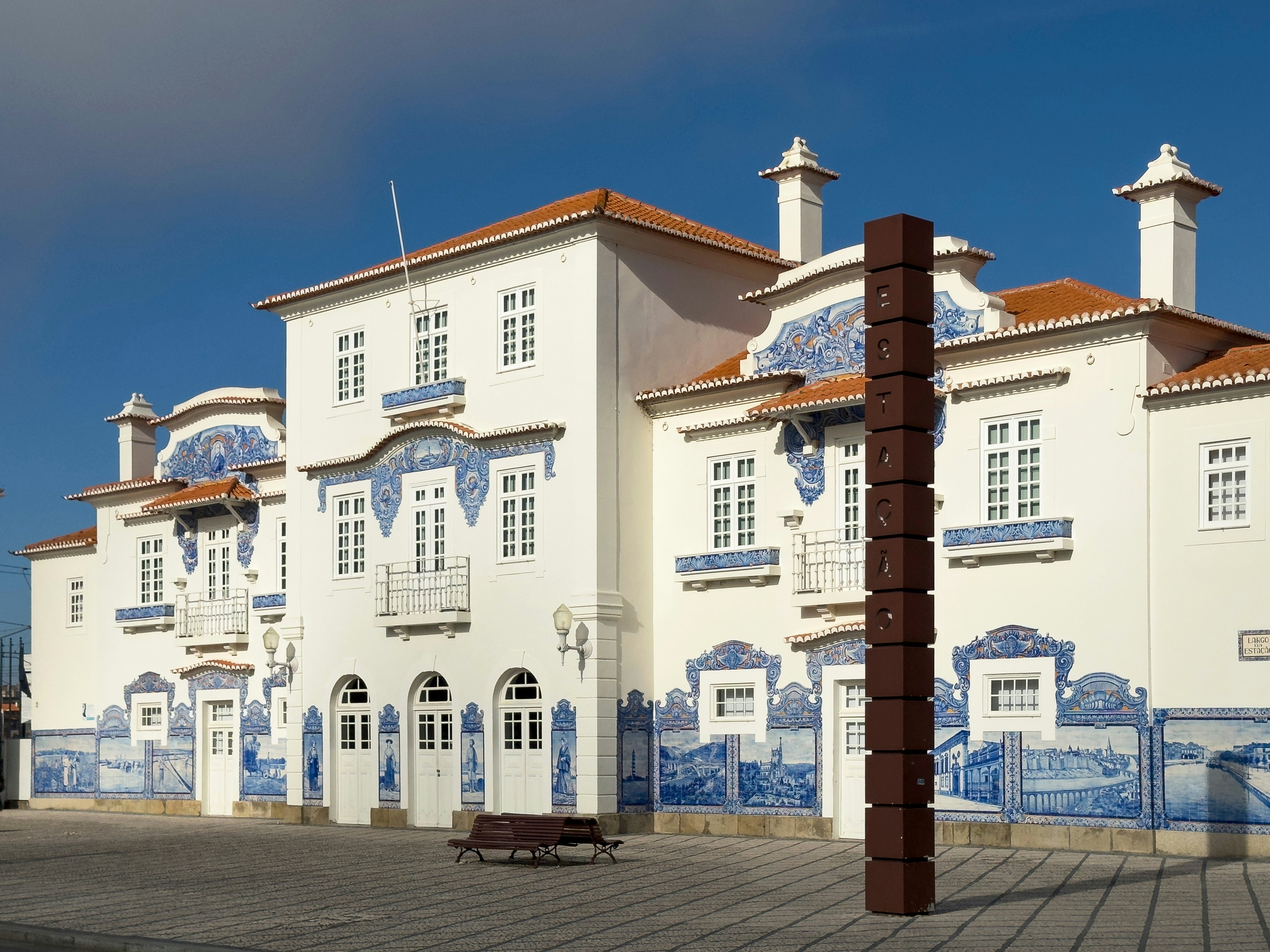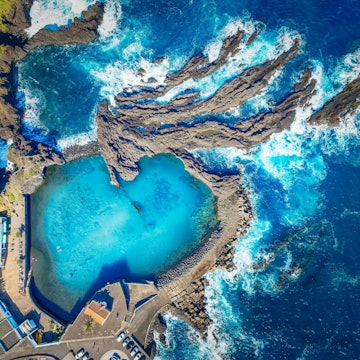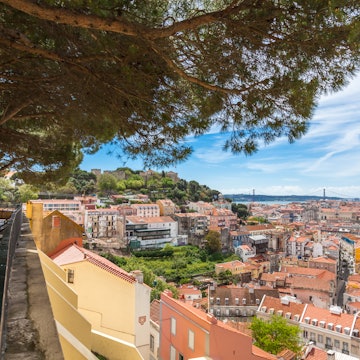
14 of the best things to do in Aveiro, Portugal's lagoon-side city

Aug 13, 2025 • 10 min read

The Aveiro canals. RossHelen/Shutterstock
Elegant, energetic and just a jump from dune-ribboned beaches and bird-sheltering salt pans, Aveiro is perhaps Portugal’s least “Portuguese” city – and not in a bad way.
Abundant art nouveau delivers an alternative backdrop. Gondola-like vessels supersede vintage trams. And ovos moles, the local eggy sweet treat, push pastéis de nata (custard tarts) out of the picture. All of this makes it an endearing change of scene between Lisbon and Porto.
That’s not to say Aveiro eschews the country’s classics. There’s enough baroque gilding, seafaring stories, hand-painted porcelain and provincial wines to keep this university city undeniably Portuguese. Here’s how to experience the best of Aveiro, from canal to coast.
1. Glide along the canals aboard a playfully-painted moliceiro
Aveiro’s canal-crawling, high-prowed moliceiro boats have earned the city a cliché comparison with Venice. But while these colorful, gondola-like crafts now ferry groups, they were locally designed in the 19th century to gather moliço (aquatic fertilizing plants) from the Ria de Aveiro, the hulking lagoon caressing the city.
Sporting four painted panels depicting anything from religious symbols to questionable humor, there were once thousands of these vessels scattered across the lagoon. Their numbers are much fewer now, and in 2025 they were nominated to UNESCO’s urgent cultural safeguarding list.
So, while some would argue that gliding along the canals under ribbon-dangling bridges by moliceiro has become a little touristy, I say who cares. It’s a fun and picturesque introduction to Aveiro that helps keep the time-honored boat-building industry alive. Most leave Canal Central on 45-minute trips along the four main urban channels. For a more typical lagoon experience, depart from Murtosa with Terra d'água.
Detour: To glimpse a moliceiro master at work, make an appointment with José Rito at the Monte Branco Shipyard, one of only five workshops still operating.

2. Study, scrub, swim or sleep in the salinas (salt pans)
Salt has shaped Aveiro’s story since Roman times. From conserving Newfoundland’s bacalhau (cod) in the 16th century to a booming colonial trade with Brazil, the city’s salinas have worked overtime. Creep atop the ridges of the open-air Ecomuseu Marinha da Troncalhada, watch the marnotos (salt workers) and learn about the ancestral methods on panels.
Fancy a float? Or a full-body salt scrub or mud spa? Cale Do Oiro and Marinha da Noeirinha offer seasonal bathing and wellness experiences alongside more in-depth tours. If you’re all-in on the white gold, book a stay in a cabin-like houseboat stilted above the salinas.
Planning tip: Salt harvesting is seasonal due to rains; preparation work usually starts in March and is completed around September.

3. Admire the azulejos at Aveiro’s old train station
Adjacent to Averio’s modern train station, the Antiga Estação is a work of art. Adorned with 59 blue and white azulejo panels depicting local and national landscapes, people and panoramas, it’s a remarkable railway welcome. Most of the panels were painted in 1916 at the Fonte Nova Factory – now Aveiro’s redbrick congress center on the fringes of the former olaria (pottery) neighborhood – with two more recent editions on the platform side.
Detour: Take a 30-minute train ride north to Ovar to walk the Rua do Azulejo trail. En route, pause at Válega and Cortegaça to appreciate two churches clad in astonishing azulejos.
4. Gawp at architectural gold in the Museu de Aveiro
Set inside a 15th-century Dominican convent, the Museu de Aveiro (not to be confused with the far-less flamboyant Museu da Cidade do Aveiro) sparkles. Spend an hour roaming the cloisters, outlandishly gilded chapel and opulent chambers radiating with gold, azulejos and elaborate wooden paneled ceilings.
The interior choir is dominated by the brightly embellished baroque marble tomb of St Princess Joanna, who resided in the convent. Architecture aside, the exhibitions focus on religious art, displaying triptychs, classical canvases and sacred statues.
Detour: Other religious buildings worth a peek are the Catedral de São Domingos, the heavily gilded Igreja de São João Evangelista, and the solemnly-tiled Igreja da Misericórdia.
5. Pair seafood with seaweed brews and samphire-infused gins
Where better to have your grilled robalo (bass) or shellfish platter than in the old fishing neighborhood, Bairro da Beira-Mar? Located around the Mercado do Peixe (officially known as Mercado José Estevão), the district is characterized by vivid, low-rise houses, which are incredibly photogenic along the often mirror-like canal.
You’ll find some first-class fresh fish in the neighborhood. Tasca do Sal pairs pretty views with quality petiscos (sharing plates), while tucked-away Palhuça is perfect for unfussy, local vibes and arroz de tamboril (monkfish rice). For saline sips, see the friendly fellas at Salicornia to try their seaweed-infused beer. Tough Love and Maldita microbrewery are other cracking craft beer bars, but you can also order a G&T with local samphire-distilled Exceptional Gin.

6. Immerse yourself in all things art nouveau
Aveiro abounds with arte nova (art nouveau), a reminder of the city’s early 20th-century affluence and the returning colonial émigrés who flaunted their wealth. Hunting out these pastel-hued facades embellished with floral motifs is a delight.
Start your self-guided tour at the Museu Arte Nova, which occupies the city’s prettiest period building, Casa Major Pessoa. The museum is underwhelming – the entrance hall and courtyard cafe, Casa de Chá (arrive early to snag the cute turret-like corner table) are the standouts. You can collect a map here that pinpointing the principal examples of arte nova in the city. Some are adjacent, while others, such as mustard-hued Casa da Silva Rocha, are hidden down backstreets.
Planning tip: Buy the €10 (US$12) four-museum pass at the Museu Arte Nova, the Museu da Cidade, Troncalhada Saltworks or Museu de Aveiro.
7. Purchase (or paint) your own set of Portugal’s finest porcelain at Vista Alegre
Since being anointed a royal factory in the 1820s, porcelain producer Vista Alegre has become a household name with retail branches nationwide. But in Aveiro, it’s best to bypass the downtown store and head straight to the company’s original factory in Ílhavo.
Alongside an outlet retailing all the regal-quality pottery you’ll instantly want in your home, the Vista Alegre Museum documents the evolution of Portuguese ceramics, porcelain and glassware across a vast complex including a chapel, a theater and former workers' lodgings. Watching the adept painters at work is mesmerizing – even more so if you join them for a masterclass.
Planning tip: Buy museum tickets on the day of your visit or book pottery workshops in advance. Details are listed on the Portuguese section of the website – most classes aren’t bilingual.

8. Explore the Ria de Aveiro’s birds and bivalves by bike or boat
Harboring oysters and clams below and a herons, storks and flamingos above, the vast Ria de Aveiro lagoon is an invitation beyond the urban. Hop on a bike or join the residents jogging along the Passadiços Ria de Aveiro, an 8km (5-mile) wooden walkway spotlighting birdlife, marshes and mudflats. For a closer inspection, book Sterna’s solar-powered boat trips for near-silent bird spotting or Ostraveiro for oyster farm visits and tastings.
Planning tip: Aveiro’s BUGA bike-sharing scheme is an affordable way to explore the city and its pathways. Download the app to collect and drop off bikes at any station.
9. Savor or assemble ovos moles, a sticky, sweet egg treat
Forget about pastéis de nata – Portugal’s beloved custard tarts. In Aveiro, it’s all about the ovos moles. Like their famed counterparts, these “soft eggs” are doçaria conventual (conventual sweets), created in Aveiro’s 16th-century convent. Sugar syrup is whisked with egg yolk and then encased in delicate wafers shaped like shells.
You’ll find them everywhere. Fanciful Confeitaria Peixinho is the oldest retailer, reportedly using the original recipe, but I’m a fan of unpretentious M1882’s version and its other local baked treats. Spend 30 minutes at Oficina do Doce (email ahead to book an English language workshop), and you can master making your own.
Planning tip: If you’re in Aveiro for the Festas de São Gonçalinho (around January 10), you’ll discover another tasty tradition when cavacas (iced, hard cakes) are tossed from the Chapel of Saint Gonçalinho’s roof into awaiting crowds.

10. Sunbathe or catch a wave in colorfully striped Costa Nova
Just 20 minutes' west by bus, Costa Nova is Aveiro’s easy beach escape. Popular for its palheiros – regional fishing cottages painted in saturated stripes – the coastal village thongs in summer when sunbathers flit between dune-backed Praia da Costa Nova and in-demand seafood restaurants. Surfers and keen amateurs should head to Praia da Barra year-round, while stand-up paddle board and kayak rentals are best on the calmer Barrinha Lagoon.
Detour: For a less congested beach experience, head south along the Costa de Prata to Praia da Mira. Endless dune-backed sands, surf and lagoon-stilted bungalows make it a favored local bolt-hole.
11. Learn local seafaring legends at the Museu Marítimo
The often unforgiving Atlantic Ocean has shaped Aveiro’s way of life and landscapes. Among the most pivotal ocean events were 1575’s winter storms, which shifted sandbars, shuttered the navigable channels and essentially ended ocean trade for centuries.
These seafaring stories and more are recounted in the contemporary Museu Marítimo de Ílhavo, which houses information on arte xávega – a local fishing method of pulling nets to land by rope – historical moliceiro and a baffling fish tank. There are two further outposts: nearby Centro de Religiosidade Marítima, exploring the ancestral link between ocean and devotion, and the Navio Museu Santo André, a former cod fishing trailer (a 15-minute drive).
Detour: To see the last remaining fishers using the arte xávega method, plan a morning visit to Praia do Areão or Praia da Vagueira, down the coast from Costa Nova. Ria Viv'arte can arrange more hands-on experiences.

12. Seek birdsong serenity amongst São Jacinto’s dunes
When Costa Nova gets crowded in summer, beeline to São Jacinto Beach by ferry. This sensational sweep of silky sands remains relatively subdued year-round thanks to the longer drive. Backing it all is the Reserva Natural das Dunas de São Jacinto, a pine-shaded, dune-laced nature reserve webbed with trails, frog-inhabited ponds and bird hides.
Start at the diminutive interpretation center to hear about recent sightings and resident species before tracking the 8km (5-mile) looped route. Boardwalks angle toward the beach, but to protect the dunes, the shoreline isn’t accessible via the park.
Planning tip: Ferries depart from Forte da Barra in Ílhavo a dozen times daily with guaranteed connections to Busway's line 36 from the city center. Bikes, including BUGA, can be taken onboard, though there’s no docking station in São Jacinto.
13. Head underground for an unexpected art and wine blend at Aliança
You could sip the bold Baga reds or espumantes (sparkling wines) of the local Bairrada wine region along Aveiro’s canals, but you’d be missing out on some subterranean surprises. Instead, venture 35 minutes' southeast to the Aliança Underground Museum, a vast whimsical wine world.
Here, guides don’t only cover the expected bottling, blending and end-of-tour tasting but also whisk you through eight extensive and unexpected cave-embellishing art collections. Spanning local ceramics, Niger artifacts, Zimbabwean sculptures and ancient fossils, the 90-minute tours are an unanticipated whirlwind.
Detour: Continue by rail to Curia, where the train station houses the Rota da Bairrada Association, providing wine route information, reservations and a small shop. The more in-depth Museu do Vinho da Bairrada is in neighboring Anadia.
14. Ride the rails on the vintage Vouga route
Once trundling all the way to Viseu, the partly abandoned Linha do Vouga is Portugal’s last operating narrow-gage line. Train geeks will appreciate the regular services heading to Macinhata’s outpost of the National Train Museum, while the art-filled city of Águeda is a flawless detour. In summer, book a seat on the Comboio Histórico (Historical Train) weekend services, which use early 20th-century vintage carriages for a memorable afternoon outing.















